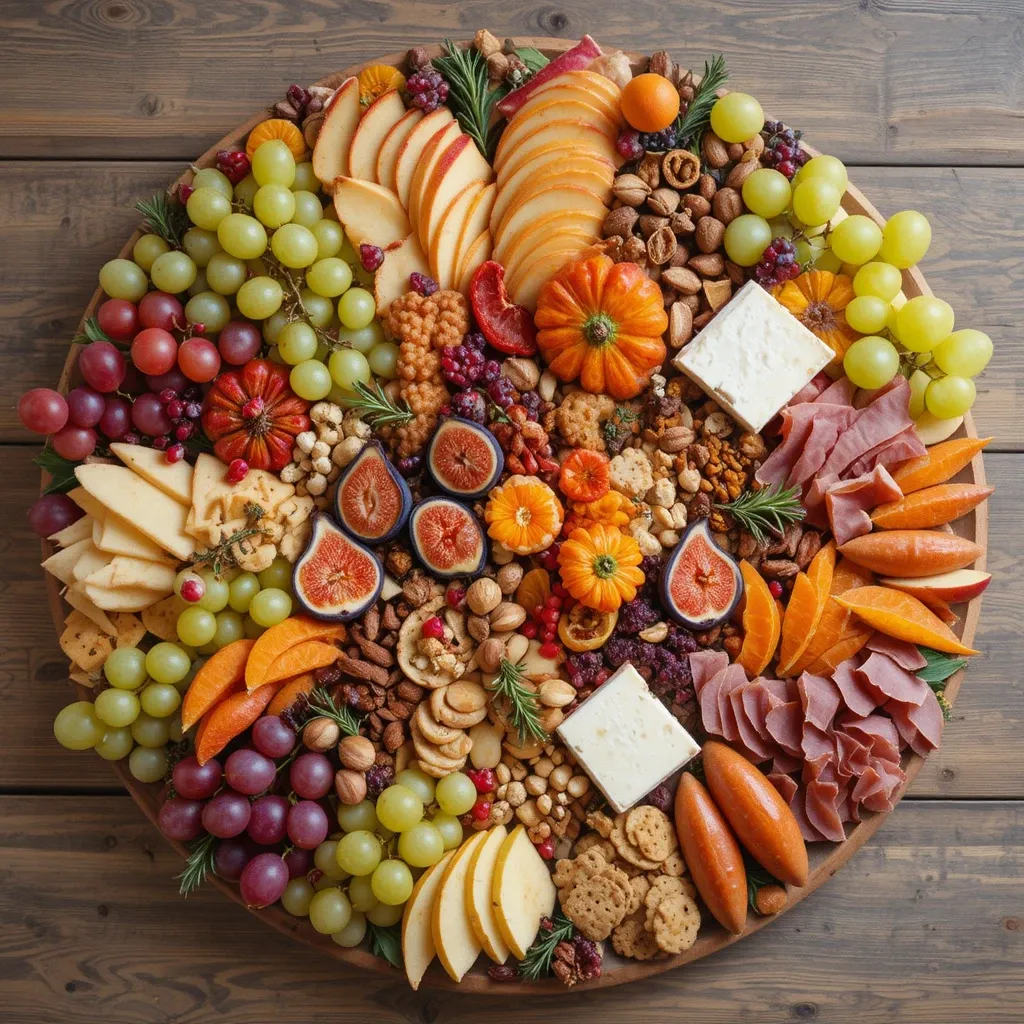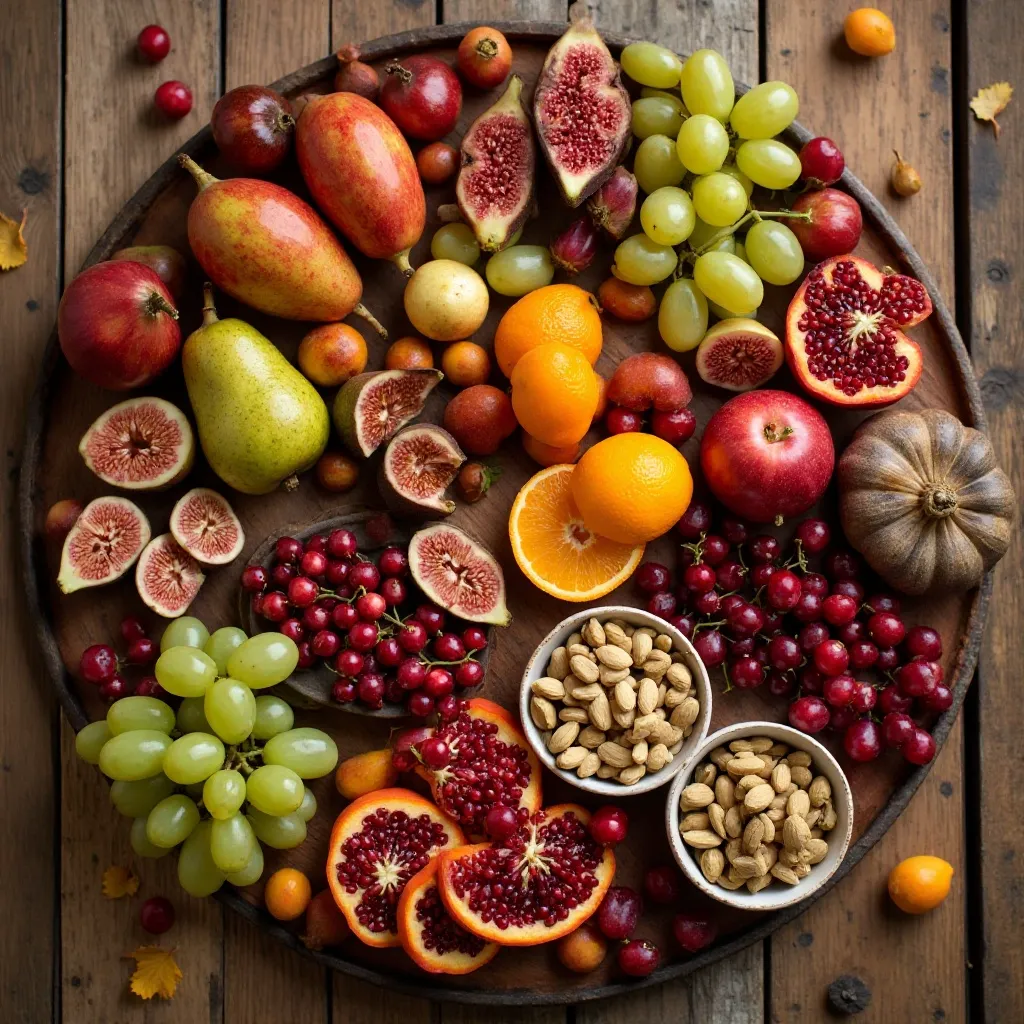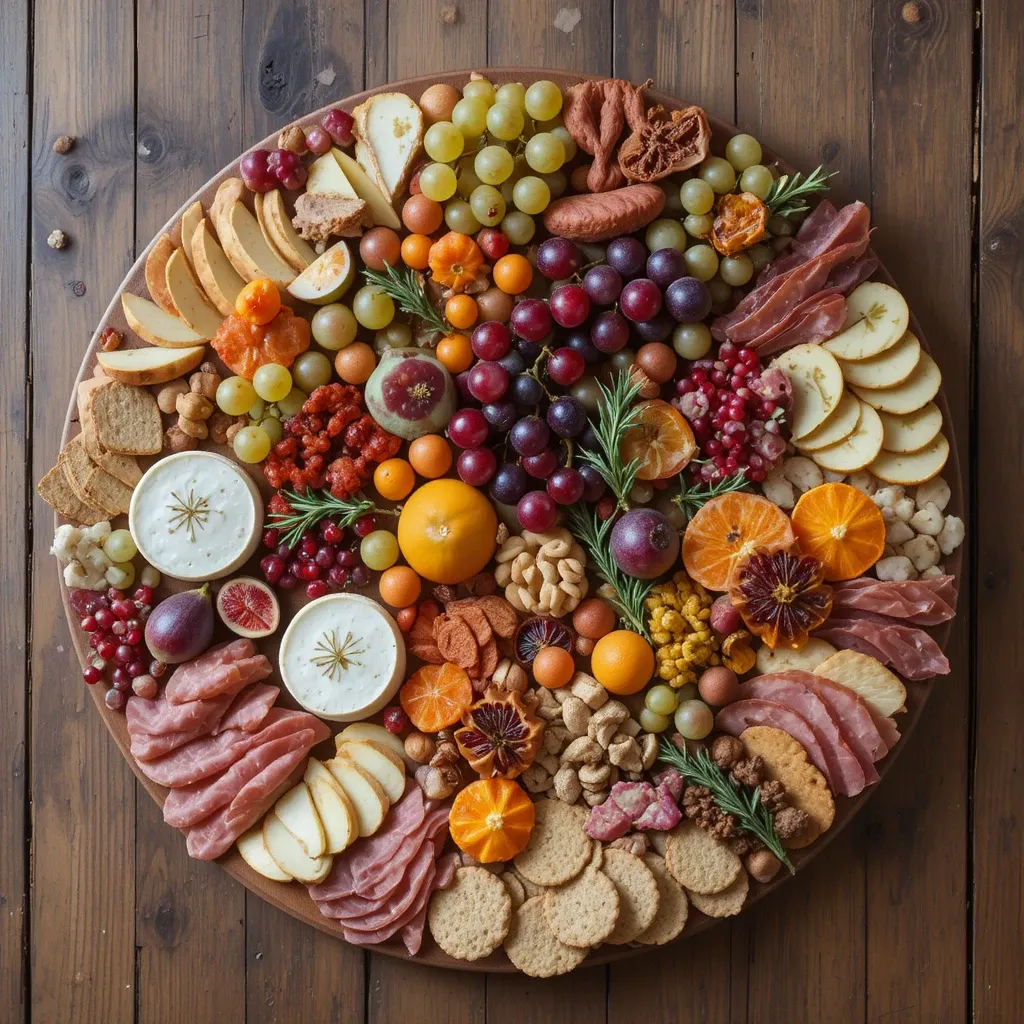The Best Thanksgiving Charcuterie Board Fruit Guide
Picture this: It’s 3 PM on Thanksgiving, your turkey’s still got two hours to go, and you’ve got hungry relatives circling your kitchen like polite vultures. Last year, I learned this lesson the hard way when my aunt Barbara literally opened my fridge looking for snacks. That’s when I discovered the magic of a proper Thanksgiving charcuterie board fruit display.
I’ve been perfecting my Thanksgiving appetizer boards for five years now, and honestly? The fruit component is what transforms a good board into one that people photograph and ask about all night.
The first time I made one, I just tossed some grapes on there and called it done. Big mistake. It looked like an afterthought, because it was. But after testing different fruit combinations, arrangements, and prep methods over the years, I’ve figured out exactly what works – and what doesn’t.
Here’s the thing: thanksgiving charcuterie board fruit isn’t just about filling space between the cheeses and crackers. It’s about creating pops of color, adding natural sweetness to balance savory bites, and giving guests who can’t eat cheese or meat something substantial to enjoy. Plus, let’s be real – it photographs beautifully, which is basically a requirement these days.

Why Fruit Makes or Breaks Your Thanksgiving Board
You might be wondering why I’m making such a big deal about fruit. Can’t you just add whatever’s in your crisper drawer and move on? (I mean, you can, but your board will look like mine did in year one, and we’ve already established that wasn’t great.)
The right fruit selection does three critical things for your Thanksgiving charcuterie board. First, it provides essential acidity that cuts through rich, fatty cheeses and cured meats. Without that brightness, everything starts tasting heavy and one-note by the third bite.
Second, it adds seasonal color – we’re talking deep reds, burnt oranges, and rich purples that scream “autumn” without you having to say a word. And third, it gives people with dietary restrictions something exciting to eat while everyone else is devouring the brie.
I learned the color lesson the hard way when I made an all-beige board one year (cheddar, crackers, almonds, and… pears). My sister-in-law took one look and said, “Did something happen to your camera filter?” Ouch. But she wasn’t wrong.
Let’s Talk About the Best Thanksgiving Charcuterie Board Fruit Choices
After making this approximately 15-20 times (I host a lot of friendsgivings, okay?), I’ve narrowed down which fruits actually work for a Thanksgiving spread versus which ones just make a mess or turn brown too fast.
| Recipe Details | |
|---|---|
| Prep Time | 25 minutes |
| Assembly Time | 15 minutes |
| Total Time | 40 minutes |
| Servings | 12-15 people |
| Difficulty | Easy |
| Cost | $$ (moderate) |
| Make-Ahead | Up to 4 hours |
The All-Star Fruit List for Your Thanksgiving Board
Grapes (Red and Green) These are your workhorses. In my opinion, grapes make the biggest difference in creating visual flow on a board. I cluster them in 3-4 spots around the board to create natural “rivers” of color that guide the eye. They’re also perfect for filling awkward gaps. Pro tip: Leave them on the stem – it looks more intentional and keeps them fresher longer.
Crisp Apples (Honeycrisp, Granny Smith, Pink Lady) Here’s where I deviate from most recipes. Most people tell you to slice apples ahead of time, but I’ve noticed they start browning within 30 minutes, even with lemon juice. Instead, I set out small apples whole with a cute knife nearby, or I slice them literally 10 minutes before guests arrive. If you must pre-slice, submerge them in a mix of water with a tablespoon of lemon juice, then pat them completely dry before arranging.
Pears (Bosc or Anjou) These are less prone to browning than apples, thank goodness. I slice them into thin wedges about 1/4-inch thick. They pair beautifully with blue cheese and aged cheddar – something about the slight grit of the pear texture against creamy cheese just works.
Fresh Figs If you can find them (they’re hit-or-miss in November), fresh figs are absolutely stunning. I halve them to show off that gorgeous pink interior. They’re my secret weapon for making a board look expensive without actually spending a fortune. One package of four figs, halved and strategically placed, makes people think you’re fancy.
Pomegranate Arils These little ruby jewels are worth the annoying effort of extracting them. I scatter them in small clusters across the board – they catch the light and add these unexpected pops of bright red. Plus, they’re fun to eat. My 6-year-old nephew calls them “crunchy rubies,” which is adorable and accurate.
Dried Fruits (Apricots, Cranberries, Figs) Don’t sleep on dried fruit! I fold dried apricots into little rosettes (sounds fancy, but you literally just fold them in half twice) and tuck them near the cheeses. Dried cranberries scattered around give a seasonal vibe without trying too hard. And dried figs sliced in half show off their seedy interior, which adds texture variety.
Seasonal Options I Love:
- Persimmons: Slice Fuyu persimmons (the flat ones) into rounds. They’re sweet, they don’t brown, and they look like little orange flowers.
- Asian Pears: Crispy like apples but they stay white much longer after cutting.
- Tangerine Segments: I peel and separate them, then arrange them in a curved line. The bright orange is perfect for fall.

Fruits I’ve Tried and Rejected (So You Don’t Have To)
After testing this recipe probably 20+ times over the years, here’s what doesn’t work:
Strawberries: I know, I know – everyone uses them. But in November, they taste like crunchy water and they’re expensive. Plus, they don’t really fit the autumn theme. Save them for spring.
Melon: Gets watery and makes everything around it soggy. Also feels too summery for Thanksgiving.
Citrus Slices (oranges, grapefruit): The juice runs everywhere and makes crackers soggy. Use the segments instead if you want citrus.
Bananas: Do I even need to explain this one? They brown immediately and the texture is weird with cheese.
Kiwi: Too acidic, the fuzzy skin is off-putting even when sliced, and the bright green reads as “tropical,” not “autumn harvest.”
How to Arrange Thanksgiving Charcuterie Board Fruit Like a Pro
Okay, real talk – this is where I messed up for ages. I used to just plop fruit in random empty spaces, which made my boards look chaotic and unintentional. Here’s the method I use now that took me years to figure out:
Step 1: Start With Your Anchor Fruits Place your grape clusters first – these are your anchors. I use three clusters minimum, positioned at roughly 2 o’clock, 6 o’clock, and 10 o’clock on the board (imagine it’s a clock face). This creates a triangular flow that’s naturally pleasing to the eye.
Step 2: Add Your Statement Pieces This is where the figs and pomegranate arils come in. I group figs in sets of two or three, placing them near (but not touching) the cheese sections. The pomegranate arils get scattered in small 1-tablespoon piles in 4-5 spots around the board.
Step 3: Fill With Sliced Fruits Now you add your apple and pear slices. I fan them out in curves – it’s way more visually interesting than just stacking them. Leave a tiny gap between each slice so they look intentional, not like you dropped them. This usually takes me about 8-10 minutes to get right, but it’s worth it.
Step 4: Tuck in the Details This is where dried fruits and small seasonal items go. I tuck folded apricots into gaps, scatter dried cranberries between cheeses, and add persimmon rounds wherever I need more color. (Pro tip: If you’ve got an empty spot that feels awkward, a small cluster of dried fruit or a single fig half usually fixes it.)
Step 5: Final Touches I add fresh herbs as garnish – small sprigs of fresh rosemary or thyme tucked next to fruit groups. It smells amazing and adds that “she really thought about this” vibe.

Perfect Pairings: What Goes With Your Fruit
The real magic happens when guests start combining flavors. After years of watching people graze at my boards, I’ve noticed which combinations disappear first:
Grape + Aged Cheddar + Rosemary Cracker The sweet pop of cold grape against sharp, crumbly cheddar is unbeatable. This combo is always gone first at my house.
Fig + Blue Cheese + Walnut This is the fancy bite. The jammy sweetness of fig balances the funky, salty blue cheese, and the walnut adds crunch.
Apple + Brie + Honey + Almond Classic for a reason. I drizzle a tiny bit of honey on the brie before adding the apple slice. My kitchen smelled like a French café the first time I tried this combination.
Pear + Prosciutto + Arugula Okay, this involves adding a tiny bit of fresh arugula to your board, but trust me – it’s worth it. The peppery arugula cuts through the salty prosciutto, and the sweet pear brings it all together.
Pomegranate Arils + Goat Cheese + Pistachio Crush some pistachios and sprinkle them over a log of goat cheese, then guests can top it with the pomegranate arils. It’s like a little DIY flavor bomb.
My Top Tips for Thanksgiving Charcuterie Board Fruit Success
Use room temperature fruit I pull everything from the fridge about 30-45 minutes before assembling. Cold fruit has zero flavor, and it makes cheese firm up when they touch. Room temp fruit is sweeter and juicier – you’ll actually taste the difference.
The secret to preventing browning Besides the lemon water trick I mentioned earlier, here’s what works: After slicing apples or pears, I brush them very lightly with a mixture of equal parts honey and water (like a teaspoon of each in a small bowl). It adds a subtle sheen, prevents browning for up to 2 hours, and doesn’t add any weird taste.
Don’t slice too far ahead This is the mistake I made at my first Friendsgiving. I prepped everything at noon for a 6 PM party. By the time guests arrived, my apples looked like they’d been through a war. Now I slice fresh fruit no more than 1 hour ahead, 2 hours max if I use the honey-water trick.
Odd numbers look better Always arrange fruit in groups of 3, 5, or 7 pieces. I don’t know why this works, but it does. A cluster of 5 grapes looks intentional; a cluster of 4 looks like you ate one.
Mix textures deliberately Place crispy apple slices near creamy brie. Put juicy pomegranate arils next to crumbly aged cheddar. The contrast makes each element more noticeable and interesting.
Keep backup fruit in the kitchen I always prep 30% more than I think I’ll need. Fruit disappears fast, and nothing’s sadder than a picked-over board at 4 PM when you’ve still got three hours of hosting ahead. I keep extra grapes washed, extra dried fruit in a bowl, and a few more sliced fruits in the fridge ready to replenish.
How to Store and Prep Your Fruit Ahead
Night Before:
- Wash all grapes and berries, dry them completely, store in the fridge in a paper towel-lined container
- Prep dried fruits (fold apricots, portion cranberries into a small bowl)
- Extract pomegranate arils, store in an airtight container
Morning Of:
- Slice figs and store in a covered container (they’re fine for 8-10 hours)
- Prep honey-water mixture in a small bowl, keep in fridge
1 Hour Before Guests Arrive:
- Pull all fruit from the fridge to come to room temp
- Slice apples and pears, brush with honey-water mixture
- Start assembling your board
During the Party:
- Keep backup fruit in the kitchen
- Refresh the board every 90 minutes or so
- Add new grape clusters where old ones were demolished
What to Serve Alongside Your Thanksgiving Charcuterie Board Fruit
Obviously, this board needs cheese, crackers, and some meat or vegetarian protein options. But here’s how I round mine out:
Cheese Selection (I always include 4-5 varieties):
- One soft cheese (brie or camembert)
- One hard aged cheese (aged cheddar or Gouda)
- One blue cheese (Gorgonzola or Stilton)
- One crowd-pleaser (sharp white cheddar or Gruyere)
- One wild card (maybe a cranberry cheddar for Thanksgiving)
Meats:
- Prosciutto (always)
- Salami or soppressata
- Turkey slices (keeping it seasonal)
Crackers and Bread:
- A variety of crackers (plain water crackers, rosemary crackers, seeded crackers)
- Sliced baguette
- Nut-based crackers for texture
Other Additions:
- Nuts (marcona almonds, candied pecans, roasted pistachios)
- Olives (both green and kalamata)
- Honey or fig jam in a small bowl
- Whole grain mustard
- Dark chocolate pieces (controversial, but I love it)
Common Questions About Thanksgiving Charcuterie Board Fruit
How much fruit do I actually need? I use this formula: For every 8 guests, include at least 2 cups of fresh fruit (after washing/slicing) plus 1/2 cup dried fruit. So for 16 guests, you’d need 4 cups fresh and 1 cup dried. It sounds like a lot, but fruit goes faster than you think.
Can I make this dairy-free? Absolutely! The fruit component stays the same – just sub in nut-based cheeses or hummus for the dairy cheese. The fruit becomes even more important on a dairy-free board because it adds moisture and interest.
What if I can’t find fresh figs? No worries – use dried figs instead (slice them in half to show the inside), or substitute with fresh pear slices arranged in a fan pattern. It’ll still look beautiful.
Help! My board looks messy and not Instagram-worthy. I’ve noticed that boards look messy when there are too many gaps or when items are too evenly distributed. Try this: Overlap some elements slightly, create some areas of abundance (like a really full section of grapes) next to sparser areas. The contrast makes it look purposeful instead of chaotic.
How do I keep fruit fresh during a long party? Keep the room cool (I actually turn my thermostat down a degree on party days). Use a larger board so the fruit isn’t crushed together – air circulation helps. And refresh with new fruit every couple hours from your backup stash in the kitchen.
Why This Approach Works for Thanksgiving Specifically
Traditional charcuterie boards are lovely year-round, but thanksgiving charcuterie board fruit selections need to feel seasonal. We’re not doing summer berries or tropical vibes here. The fruits I’ve recommended – apples, pears, figs, pomegranates – all hit peak season in autumn and carry these warm, cozy flavors that pair beautifully with fall cheeses and nuts.
Plus, after testing different combinations, I’ve found that these particular fruits hold up better during a long Thanksgiving day. You’re not putting this board out for a quick 2-hour cocktail party – you’re feeding people from mid-afternoon through dinner prep and sometimes even after dinner. You need fruits that don’t wilt, don’t weep juice, and still look appealing four hours in.
My Final Thoughts
The first Thanksgiving charcuterie board I ever made was kind of a disaster – I spent $70, it looked chaotic, and half the fruit turned brown. Now? I can put together a stunning board in about 40 minutes that gets photographed, compliments, and completely devoured. The secret isn’t fancy ingredients or expensive imported cheese – it’s understanding how fruit works on a board and taking the time to arrange it thoughtfully.
Don’t stress too much about perfection. Even my boards that I think are “just okay” get rave reviews, because honestly, people are just excited to have something beautiful and delicious to snack on while waiting for dinner. Start with good fruit, arrange it in odd-numbered clusters, mix your colors thoughtfully, and you’ll have a board that looks like you paid someone to make it.
Now go forth and create a thanksgiving charcuterie board fruit display that makes Aunt Barbara forget to raid your fridge! And hey, if you try this out, I’d love to hear how it goes. What fruit combination was the first to disappear at your house?
